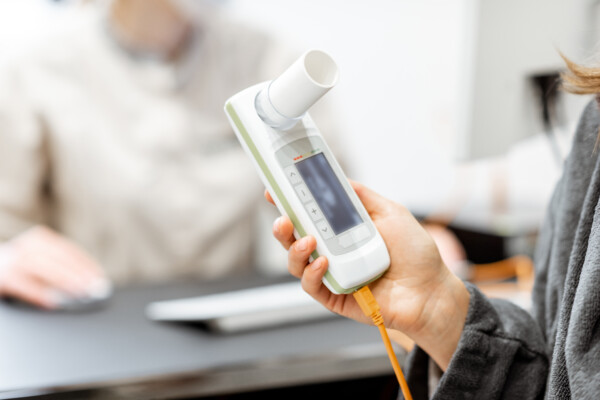As there is no single test for asthma, diagnosis involves a mixture of factors. Speak to your GP if you suspect you or your child may have asthma.
Factors used to make a diagnosis
As there is no single test for asthma, your GP will make this diagnosis based on:
- A family history of asthma (if there is one)
- The pattern and frequency of symptoms
- A physical chest examination
- Peak flow readings or a lung function test (children must be over 5 years old)
- A trial of asthma treatment
Before asthma can be confirmed or ruled out, your doctor may also ask you about other conditions which may be present, such as eczema or hay fever. You may also be asked to keep a diary of the symptoms you or your child have and when they occur.
Tests for asthma
Spirometry

Spirometry is a breathing or lung function test. It measures how much air you can breathe out in one forced breath. You may do a spirometry test at the GP surgery, or you may be given a short appointment at a clinic/hub or hospital outpatients department. It is used to diagnose and monitor some lung conditions such as asthma and COPD.
Who can have a spirometry test?
Spirometry is suitable for most adults, young people, and children over five.
The spirometry test increases pressure in your head, chest, stomach and eyes and therefore, it may not be suitable for you if you have, or have recently had:
- Angina
- Heart problems
- Concussion
- Uncontrolled high or low blood pressure
- Pulmonary hypertension
- Pulmonary embolism
- Pneumothorax
- Recent surgery on the brain, middle ear, sinuses, eyes, chest or abdomen
- Late-term pregnancy
- Aneurysms
How is a spirometry test done?
A spirometry test is done using a small machine attached to a mouthpiece, called a spirometer. The nurse or healthcare assistant can show you how to blow into the spirometer before starting the test. To do the test you need to:
- Sit comfortably
- Wear a clip on your nose to make sure all the air from your lungs goes into the mouthpiece.
- First do a relaxed breath – it is often described as a big sigh into the machine.
- Then take a deep breath and breathe out as fast and as hard as you can, for as long as you can, through the mouthpiece.
You will need to blow a few times and put as much effort into the test as you can, to get an accurate result.
Some people can feel a bit dizzy, lightheaded or faint afterwards, but this usually lasts just a few minutes.
How is spirometry used with a bronchodilator reversibility test?
A spirometry test is often done alongside a bronchodilator reversibility test (BDR).
The two tests together can show if your airways open up with bronchodilator medicines, and if so, by how much.
Spirometry used with a BDR test can show:
- If symptoms might be caused by asthma, COPD, or Asthma-COPD overlap (ACO). ACO is where people have features of both asthma and COPD. If your airways open up well after taking reliever medicine through a spacer, it makes it more likely that you have asthma or COPD.
- How well your medicines are working, particularly if your treatment plan has changed.
How is a BDR test done?
If the spirometry test shows that your airways are narrowed, you may need to do a BDR test. This is when you do a second spirometry test after taking bronchodilator medicine. This allows your healthcare professional to check how your airways respond to the bronchodilator medicine. Here are the steps involved in a BDR test:
- First you do a spirometry test. Your healthcare professional will take note of the results.
- Then you use your reliever inhaler or other bronchodilator medicines.
- You wait 15-20 minutes and then do another spirometry test.
If you use inhalers, you should bring them, and your spacer if you have one, to your appointment.
What do my spirometry and BDR test results show?
You won’t get your results straight away. They will need to be looked at by a specialist first. Your healthcare professional will then talk through the test results with you.
For embedding: https://www.youtube.com/watch?v=6dNPNEfstl0
Peak Expiratory Flow Rate (PEFR)
This is another simple breathing test which may be carried out over a period of time, such as when one has symptoms or is symptom-free. It can be performed by a GP, in a hospital, or even at home.
Exercise testing
This test is used to check if exercise makes your symptoms worse.
Diagnosing Children
Asthma is difficult to diagnose in children under the age of two. This is because both wheezing and respiratory infections are common in young children and can have very similar symptoms to asthma.
